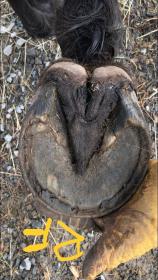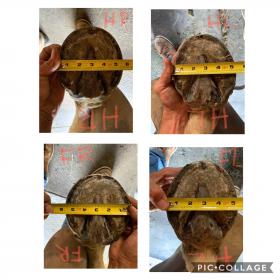Hello!
30+ year equestrian here. I have recently got back into horse ownership this summer with a wonderful 3-year-old fjord gelding named Charlie. He came to me shod with borium on all fours as he had been trained to drive and needed the extra traction on the road. Totally understandable. After our first two weeks, I noticed that the shoe nails were starting to protrude from his hoof wall and even though it was only about 4 weeks total from his last reset, I had my blacksmith come out to take a look and have him reset. At 2.5 weeks from his reset with me, the hoof nails were starting to protrude again. I didn’t like how sharp they were and how quickly this was happening…nor the implications of his shoes shifting and having to have new nail holes potentially at an increased rate.
The root cause of this as it was explained by my blacksmith is a combination of A) 12+ hour daily turnout time (4 geldings on 30 acres), B) hoof swell/softening of standing in grass with morning dew on it, C) impact from stomping flies. His recommended was essentially less turnout if I wanted to keep the shoes on and not have this happen so quickly. I want my horses to have as much turnout as possible so needless to say, I wasn’t all about this suggestion. I asked his opinion on boots, and to my surprise, he seemed to think that could be a good solution and recommended Scoot Boots which I am impatiently awaiting their arrival haha.
I had his shoes pulled last Wednesday the 19th and he seems to be doing ok. I know that that it will take some time for him to develop callouses and strength on different terrain to be completely sound barefoot. This is where I could use some advice/support as I am a huge worrier. I understood for this to happen, he needs to move, and he needs to be slowly introduced to the harsher terrains.
My boarding barn has 900+ acres of trails (it’s amazing) and a large outdoor sand arena. To get to the softer trails, there is gravel all-weather trails you have to walk on first so I have put a pause on any trail riding until I get my Scoots in. I gave him Wednesday off, did a very light 20-minute ride in the arena Thursday and he was ok, had a 40-minute lesson with my trainer Friday which he was solid during the ride mostly walking, a little bit of trotting and a brief canter both directions. I could tell he was tender later after the ride but again, was doing ok. He had Saturday off and I did 20 mins today in the arena of light (mostly walking/lateral work) and I felt him take a couple off steps but otherwise felt normal.
I have never transitioned a horse to barefoot before, and thankfully do have my trainer to get insight from and am working Charlie under her guidance. I tend to err on being super conservative/worry wort with things like this, probably to the point of shying away from much that I know will make him ouchy and I feel conflicted about even the light work that I have done. If he is stepping carefully out of his stall or on the grass, I wouldn’t think about riding at even the walk in the sand, but he has been ok on the softer terrains. He is a fjord, and therefore really a draft pony and his hooves seem to be in pretty good shape with no concerns from my blacksmith or trainer. No issues with his hoof shape for fitting the Scoots (they sized him via photos/measurements) either. In theory, we should be ok given some time and I am in no rush with him, especially with him still being on the younger side and working on foundational training and relaxing/balance on the trails.
Any advice? Even with the Scoots, I know I will have to introduce to rougher terrain barefoot if I want him to acclimate. I am so conditioned to see a horse take a misstep and having it be a cause for concern and not part of conditioning. I know how I walk barefoot outside on gravel with not being used to it and it’s not pretty lol, but the more I do it, the less discomfort. I should add that I intend to give him time off until the Scoots arrive to let him heal any sore spots he may have developed.


 ). It also sounds like you already have this sort of mindset going into the process, so I hope this doesn’t sound preachy!
). It also sounds like you already have this sort of mindset going into the process, so I hope this doesn’t sound preachy!

 I was also hoping that with him being so young, and not really having had shoes on for very long, we would be at an advantage to transition vs a horse that has had shoes on for a decade plus of their life. I have attached the photos I submitted to Scoot to give an idea of where we are starting from at least. I just ordered The Essential Hoof book and am anxious to dive into that to learn more. For being around horses most of my life, I don’t know nearly enough about their feet as I would like to. My order from Scoots has been moving very slowly and I just got confirmation today that it was off delivery exception and should be here next Thursday the 3rd which is much later than expected. The tack stores in my area do not have his size, and neither does the stockist in the area. If they do not fit well when they do arrive, I am going to have the stockist come out and fit him. I feel like by the time that is all sorted he’s going to be adjusted hahaha.
I was also hoping that with him being so young, and not really having had shoes on for very long, we would be at an advantage to transition vs a horse that has had shoes on for a decade plus of their life. I have attached the photos I submitted to Scoot to give an idea of where we are starting from at least. I just ordered The Essential Hoof book and am anxious to dive into that to learn more. For being around horses most of my life, I don’t know nearly enough about their feet as I would like to. My order from Scoots has been moving very slowly and I just got confirmation today that it was off delivery exception and should be here next Thursday the 3rd which is much later than expected. The tack stores in my area do not have his size, and neither does the stockist in the area. If they do not fit well when they do arrive, I am going to have the stockist come out and fit him. I feel like by the time that is all sorted he’s going to be adjusted hahaha.
